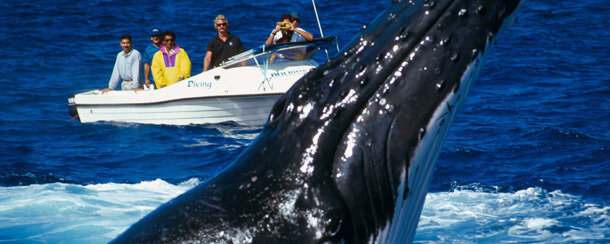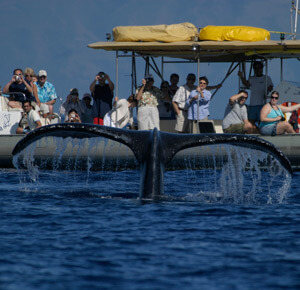Whale watching, defined by the IWC as any commercial enterprise which provides for the public to see cetaceans in their natural habitat (IWC 1994) is one of the fastest growing tourism products in the world. Thirty-four of the 40 IWC member countries (85%) now have whale watching activities (Hoyt 2001) , and ironically, it is a rapidly growing activity in countries that still hunt whales such as Norway and Japan. As of 1998, over 100,000 people went whale and dolphin watching in Japan, spending an estimated $33 million (USD) (Hoyt 2001) . Annual income from whale watching here far outweighs that of the sale of whale meat products.
In Australia the number of people going whale watching has grown at an average of 15% annually over the last 5 years (IFAW 2004). Comparatively the international tourism market shows an average growth of only 2.76%. Australia now hosts 1.5 million whale watchers contributing close to $300 million to the national economy annually (IFAW 2004) . The growth of the industry is the highest in NSW, which experienced 37% growth in the period 1998 – 2003 (IFAW 2004) .
In many places such as Kaikoura, New Zealand, and the Kingdom of Tonga, whale watching provides valuable income to local indigenous communities, with the creation of jobs and business. In the Kingdom of Tonga whale watching generates an estimated USD $700,000 annually for the Tongan national economy (Orams 2002) . Communities here benefit not only from direct expenditure on whale watching activities but also from flow-on effects of tourism such as transport services and hotels.
Not only can whale watching help to raise awareness about marine conservation issues, but also it often provides a platform for scientific research, ultimately contributing to the conservation of the animals. Moreover the activity represents a diversity of values in addition to economic. (IFAW 1999) concluded that the true value of whale watching is more than just expenditures by tourists. Values associated with it can be recreational, cultural, aesthetic, spiritual and political which in essence are ‘non-use values’. Whale watching nature tourism exemplifies a key objective that defines sustainable use, where benefits result from the potential for use by future generations.
The lifestyle of coastal people has always been intimately linked with the marine environment and its resources and increasingly maritime nations are looking at new, more sustainable ways to generate a livelihood from the sea, including a strong focus on the development of whale watching. Whale watching nature tourism here has the potential to become a vehicle for transforming conservation and research into key economic forces. Marine mammal viewing can result in conservation and socioeconomic benefits for the animals and local communities alike if it is conducted responsibly (Spradlin, Barre et al. 2001) . (Orams 2001) agrees that whale watching tourism is likely to lead to a greater appreciation of and public desire to conserve, the wildlife involved.
Whale watching as a commercial endeavour has many important educational, environmental, scientific, and other socioeconomic benefits. (IFAW, WWF et al. 1997) suggests that the most valuable thing about whale watching is the potential to educate people.


